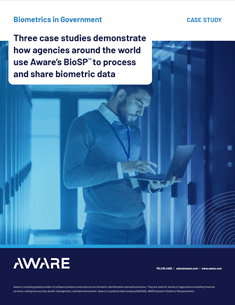Revolutionizing Border Control with Biometrics
April 27, 2023 | 4 minute read
Revolutionizing Border Control with Biometrics
April 27, 2023 | 4 minute read
The use of known physical characteristics to confirm the identity of an individual has been used by state authorities for over 100 years. However, recently, biometric technology has emerged as a game-changer in border security. In this blog, we’ll explore the beginnings of biometric technologies and how they’re being developed and incorporated into modern border control procedures to increase security, improve border agencies’ operational efficiency, and generally provide a more pleasurable experience for the average traveler.
In the late 1800s, Alphonse Bertillon (a French criminologist) revolutionized the world of criminal identification. This way of identifying people involved measuring five distinct physical characteristics of individuals to ensure their accurate identification: head length, head breadth, middle finger length, left foot length, and the length from the elbow to the tip of the middle finger, also known as “cubit”. Though basic by today’s standards, Bertillon’s pioneering methods continue to inform the biometric matching technologies of our modern times.
Today, biometric technology serves not only as a security measure, but also as a vital tool in expediting the flow of people or goods across borders. With the widespread integration of biometric systems, common occurrences have become the norm (like using your iPhone to unlock your device with facial recognition). However, the benefits of biometric border control extend far beyond personal convenience. At border crossings, even brief delays spent waiting for manual document verification can rapidly accumulate, resulting in long queues of frustrated travelers in crowded international terminals. Luckily, the implementation of biometric technology like eGates or biometric passports looks to greatly ease the strain on international travel outside of the U.S. by allowing their system to electronically match your face to the chip in your passport.
Not sure if you’re familiar with eGates or biometric passports? Well, they’re far more common than you think. An eGate (also known as an ePassport Gate) is “an automated self-service barrier” that allows travelers to quickly and efficiently pass through border control. These gates are currently utilized by the U.K. Border Force at a number of airports across the country. The system operates by utilizing advanced technology to scan biometric information stored in a traveler’s biometric passport (also known as an ePassport), such as their facial features and passport chip data. These devices provide an alternative to traditional, manned immigration desks, offering a faster and more streamlined experience for travelers whilst also freeing up staff to concentrate on other aspects of border security.
But what about in the United States? Well, U.S. Customers and Border Protection (CBP) has also been hard at work to implement entry and exit processes at all international airports, seaports, and pedestrian lanes through their implementation of facial biometrics. CBP’s process is called Simplified Arrival and it streamlines travelers’ experience from departure to arrival. It’s currently available at 36 airport locations, as well as the Southwest Border ports of entry, and all Northern Borders across the country. According to the CBP website, they’ve “processed more than 200 million travelers using biometric facial comparison technology and prevented more than 1,600 impostors from entry to the U.S.”
The process is markedly similar to that of the ePassport Gate process in the U.K., with the number of positive responses being a good indication that the system is working; of course any sort of expedited process is going to receive acclaim from travelers, but Simplified Arrival also reduces the risk of any sort of imposter threat, and (in the wake of the COVID-19 pandemic) also reduces contact with another individual. Of course, as with any newly introduced system, there’s always cause for concern – this is no different, with a keen focus on the privacy of U.S. citizens. However, there’s little to fear here: While your photo is taken at the place where you’d normally present your passport, the photo is only compared to an existing passport photo and then deleted after being validated. These photos are never saved or shared.
In the aftermath of 9/11, the Department of Homeland Security was created and “inaugural CBP Commissioner, Robert Bonner, set the ‘twin goals’ of border security and facilitation of lawful travel and trade.” It was likely difficult to imagine the technological advancements we’d make in the 22 years since, but with the use of biometric technology, both security and facilitation at the border are easier to achieve than ever before.
